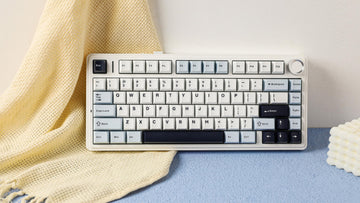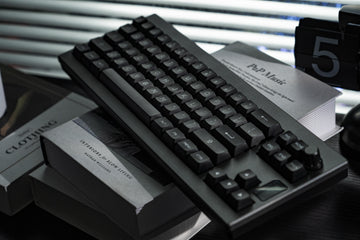Mechanical Keyboard Size Guide - Which size of keyboard should I get?
by Freya Tong on Apr 21, 2022

When we enter the rabbit hole of the mechanical keyboard in the first place, we can always find some description about the size: sometimes it is an abbreviation like TKL, and some others are percentages or numbers like 65% or 68 (which is usually the number of keys). When digging a little more into it, some might be confused about how come an 82-key keyboard is called a 75% keyboard! Now we are going to sort it out here.
Full Size / 100%

The most common size is probably the full size keyboard with 104 or 108 keys. All keys are in the standard size with large 2.25x & 2.75x shift keys, a 6.25x space bar, and all the modifiers at the bottom row are 1.25x, big enough to avoid mistyping. It comes from the traditional size with all alphabets, function keys, cursors keys, modifiers, and a numeric keypad, which is almighty for both gaming and working. If you haven't tried any mechanical keyboard before, the full size version is a good choice to start a transition.
One drawback of a full-size keyboard is that it is taking too much space on the desktop. For those who might need to travel with a keyboard, the full-size keyboard is also heavy to carry. That is mainly the reason for compact keyboards appearing in recent days.

Full Size - 104 keyboard: the standard full-size keyboard (Photo: Ajazz AK35I)

Full Size - 108 keyboard: the 108-key includes extra 4 media keys on the top right corner compared with the 104 keyboard (Photo: Niz Plum X108)
DIY kit: GK108S Kit
1800 Compact: 98 Keys & 96%


There are mainly two types of keyboards which are both considered as 1800 compact or 96% size. One rarely-seen version is to include all the keys that a full-size keyboard has, but it removes the space between different key clusters such as the home clusters and the numpad. Besides being more compact, there is no difference between this version and a full-size keyboard. The other one seems to become more popular in recent years, which not only removes the space but also rearranges the key layout to either move or skip some less-commonly used keys from the home cluster such as Insert, Home, End, and PrtSc.
To achieve the goal of saving space but remaining the function keys and the numpad, some 1800 Compact keyboards makes the specific keys smaller. For example, the right shift key is shortened to 1.75x to save space for arrow keys, while it is still large enough to avoid mistyping. The 0 key on the numpad and modifiers at the right side of the spacebar are shrunk to 1x as well. While keeping the nums and necessary keys, the 1800 compact keyboard suits those who needs function keys and a numpad in daily work. It's also a nice middle-ground choice when you are hesitant between a full size version and a Tenkeyless (TKL) version.

98-Key keyboard leaves some space between the main part and the arrow keys to be better accommodated (Photo: TH98)

96% - 100 keys keyboard: Compact 1800 type with all keys tightened together (Photo: GK96S)
DIY kit: GK96 Lite Gasket Kit
TKL - Tenkeyless - 87 keys

The Tenkeyless or TKL keyboard, like the name, is the type that bluntly cuts off the numeric pad based on the full-size keyboard. This simple action of shortening the keyboard is however very effective for those who don’t use the numpad often. On closer inspection, the 87-key keyboard is not losing any keys as there are still numeric keys and math symbols above the alphabets, and most of the keys still sit where they are without any shortening. The TKL keyboard saves enough space for a mouse and hence it is also quite popular among enthusiasts.

TKL: technically a 'full-size' keyboard (Photo: SK87 Macaron)
DIY kit: GK87S Kit, Skyline 87 Kit
75% Keyboard


A 75% keyboard is more of a compact version of a TKL: function keys and arrow keys remain, and home cluster keys reshuffle on the right side of the keyboard. Of course, to fulfill the goal to be as compact and functional as possible, some large keys like the right shift are cut to 1.75x, and the right modifiers are also reduced to 1x. This shortened size allows people to keep the alphabet area aligned with the center of the monitor, offering a comfortable typing position.
The most compact 75% keyboard goes to the one with 84 keys, whose keys are all tightened next to each other, and the function keys are aligned with the numeric keys below. Some people find it easily mistyped, so another 75% keyboard with an alternate F-row, which often houses 80-82 keys, has been created to ultimately fix this problem. In any manner, the 75% keyboard has gained its reputation for being compact, functional, and easy to accommodate.

75% - 84 keys keyboard: Compact 75% type with all keys tightened up (Photo: EP84)

75% - 80 keys keyboard 75% type with alternate-lined function keys (Photo: TH80):
DIY kit: GK84 Lite Gasket Kit, Eclair 75% Kit, TH80 Kit, Skyline 75% Kit
65% Keyboard

Still, there is a lot to dig in the compact keyboard world. For example, some people, who don’t deal with the function keys frequently, still want to get a more compact keyboard than the 75% ones. To make things bolder, this 65% keyboard is created without function keys. In fact, the 65% keyboard stands out for remaining the essential keys like alphabets, arrows, and other function keys. The advantage of being center-to-center with the screen from 75% has already been inherited because there are not many changes on the side.
If you still would like to resume the function keys on a 65% keyboard, one significant function of mechanical keyboards begins to reveal by using the Fn key or creating macros. Therefore, you are on the road to customizing your own keyboard.

65% - 68 keys keyboard: 65% type with a foldable stand (Photo: NT68)

65% - 66 keys keyboard: 65% type with a rotary knob (Photo: TH66)
DIY Kit: TH66 Kit, TH68 Kit, GK68 Lite Gasket Kit
60% Keyboard


The original generation of compact mechanical keyboards should count in the 60% ones. With the letters, a spacebar, and an enter key, it is just like a typewriter which was developed in the 1700s. Compared with the 65% or TKL keyboards, the 61-key goes further by removing the arrow keys from a standard keyboard. It was originally perfect for typists. The key sizes are not changed, just like the standard full-size with large shift keys and easy to type.
But that's not the only 60% keyboard. The mechanical keyboard world is quite flexible. Some people still find that they need the arrow keys - no problem, just add them to it! And the 64-key version came out. To give some space for arrow keys, the shift keys are reduced to 2x on the left and 1x on the right. With the possibility of programming mechanical keyboards, enthusiasts adopt this percentage to fulfill a keyboard type with compact size and powerful functions.

60% - 61 keys keyboard (Photo: Epomaker Lite)

60% - 64 keys(Photo: Epomaker Mini Cat 64 Kit) with 2x & 1x Shift key
DIY Kit: GK61 Lite Gasket Kit, Epomaker Mini Cat 64 Kit
Downsizing never ends. Don’t be limited that compact keyboards stop at 60%. There are still 50%, 40% and even a numpad of 20%! The more we explore, the more surprise we find in each size of the mechanical keyboards. Thankfully, we will keep digging more fun and share them with you. Let’s enjoy the mechanical keyboard world!






